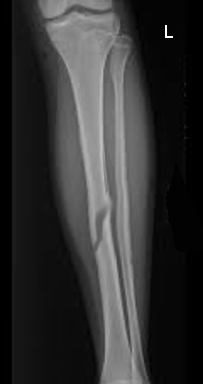[1]
Larsen P, Elsoe R, Hansen SH, Graven-Nielsen T, Laessoe U, Rasmussen S. Incidence and epidemiology of tibial shaft fractures. Injury. 2015 Apr:46(4):746-50. doi: 10.1016/j.injury.2014.12.027. Epub 2015 Jan 16
[PubMed PMID: 25636535]
[2]
Weiss RJ, Montgomery SM, Ehlin A, Al Dabbagh Z, Stark A, Jansson KA. Decreasing incidence of tibial shaft fractures between 1998 and 2004: information based on 10,627 Swedish inpatients. Acta orthopaedica. 2008 Aug:79(4):526-33. doi: 10.1080/17453670710015535. Epub
[PubMed PMID: 18766487]
[3]
Gosman JH, Hubbell ZR, Shaw CN, Ryan TM. Development of cortical bone geometry in the human femoral and tibial diaphysis. Anatomical record (Hoboken, N.J. : 2007). 2013 May:296(5):774-87. doi: 10.1002/ar.22688. Epub 2013 Mar 27
[PubMed PMID: 23533061]
[4]
Goh JC,Mech AM,Lee EH,Ang EJ,Bayon P,Pho RW, Biomechanical study on the load-bearing characteristics of the fibula and the effects of fibular resection. Clinical orthopaedics and related research. 1992 Jun;
[PubMed PMID: 1600659]
[5]
Marsh JL, Slongo TF, Agel J, Broderick JS, Creevey W, DeCoster TA, Prokuski L, Sirkin MS, Ziran B, Henley B, Audigé L. Fracture and dislocation classification compendium - 2007: Orthopaedic Trauma Association classification, database and outcomes committee. Journal of orthopaedic trauma. 2007 Nov-Dec:21(10 Suppl):S1-133
[PubMed PMID: 18277234]
[6]
Patzakis MJ, Wilkins J. Factors influencing infection rate in open fracture wounds. Clinical orthopaedics and related research. 1989 Jun:(243):36-40
[PubMed PMID: 2721073]
[7]
Anderson LD, Hutchins WC, Wright PE, Disney JM. Fractures of the tibia and fibula treated by casts and transfixing pins. Clinical orthopaedics and related research. 1974 Nov-Dec:(105):179-91
[PubMed PMID: 4430164]
[8]
Trafton PG, Closed unstable fractures of the tibia. Clinical orthopaedics and related research. 1988 May;
[PubMed PMID: 3284684]
[9]
Sarmiento A, Gersten LM, Sobol PA, Shankwiler JA, Vangsness CT. Tibial shaft fractures treated with functional braces. Experience with 780 fractures. The Journal of bone and joint surgery. British volume. 1989 Aug:71(4):602-9
[PubMed PMID: 2768307]
[10]
Melvin JS, Dombroski DG, Torbert JT, Kovach SJ, Esterhai JL, Mehta S. Open tibial shaft fractures: II. Definitive management and limb salvage. The Journal of the American Academy of Orthopaedic Surgeons. 2010 Feb:18(2):108-17
[PubMed PMID: 20118327]
[11]
Bhandari M, Guyatt GH, Tornetta P 3rd, Swiontkowski MF, Hanson B, Sprague S, Syed A, Schemitsch EH. Current practice in the intramedullary nailing of tibial shaft fractures: an international survey. The Journal of trauma. 2002 Oct:53(4):725-32
[PubMed PMID: 12394874]
Level 3 (low-level) evidence
[12]
Blachut PA,Meek RN,O'Brien PJ, External fixation and delayed intramedullary nailing of open fractures of the tibial shaft. A sequential protocol. The Journal of bone and joint surgery. American volume. 1990 Jun;
[PubMed PMID: 2355035]
[13]
Ko SJ, OʼBrien PJ, Guy P, Broekhuyse HM, Blachut PA, Lefaivre KA. Trajectory of Short- and Long-Term Recovery of Tibial Shaft Fractures After Intramedullary Nail Fixation. Journal of orthopaedic trauma. 2017 Oct:31(10):559-563. doi: 10.1097/BOT.0000000000000886. Epub
[PubMed PMID: 28538288]
[14]
Lefaivre KA, Guy P, Chan H, Blachut PA. Long-term follow-up of tibial shaft fractures treated with intramedullary nailing. Journal of orthopaedic trauma. 2008 Sep:22(8):525-9. doi: 10.1097/BOT.0b013e318180e646. Epub
[PubMed PMID: 18758282]
[15]
Willis RB, Rorabeck CH. Treatment of compartment syndrome in children. The Orthopedic clinics of North America. 1990 Apr:21(2):401-12
[PubMed PMID: 2183136]
[16]
Bae DS,Kadiyala RK,Waters PM, Acute compartment syndrome in children: contemporary diagnosis, treatment, and outcome. Journal of pediatric orthopedics. 2001 Sep-Oct;
[PubMed PMID: 11521042]
[17]
Nork SE, Barei DP, Schildhauer TA, Agel J, Holt SK, Schrick JL, Sangeorzan BJ. Intramedullary nailing of proximal quarter tibial fractures. Journal of orthopaedic trauma. 2006 Sep:20(8):523-8
[PubMed PMID: 16990722]
[18]
Toivanen JA, Väistö O, Kannus P, Latvala K, Honkonen SE, Järvinen MJ. Anterior knee pain after intramedullary nailing of fractures of the tibial shaft. A prospective, randomized study comparing two different nail-insertion techniques. The Journal of bone and joint surgery. American volume. 2002 Apr:84(4):580-5
[PubMed PMID: 11940618]
Level 1 (high-level) evidence

